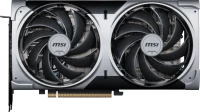Radeon RX 5700 and RX 5700 XT graphics cards: what's interesting about the new RDNA architecture?
We independently test the products and technologies that we recommend.

Features of the RDNA architecture
As many as six previous generations of AMD graphics accelerators were built on different iterations of the same GCN (Generation Core Next) architecture: HD 7000, R200, R300, RX 400, RX 500 and Vega. To continue to increase productivity by simply increasing the number of microkernels was no longer allowed by reasonable limits of energy consumption and heating. The PCI-E x16 slot and two 8-pin power connectors are capable of producing a maximum of 300 watts of electricity in total. The same amount of heat with grief in half can be taken away by a three-slot three-fan air cooler or a remote water block.
 |
The long-awaited new AMD RDNA graphics architecture, coupled with the latest at the moment 7-nanometer TSMC process technology, allowed to reduce power consumption by one and a half times with equal performance, or to increase performance by 50 percent with the same power consumption. For the first two RDNA video cards — Radeon RX 5700 and RX 5700 XT — AMD engineers wisely chose the middle option: they reduced the power consumption by about a quarter and at the same time increased the performance by the same amount. It became possible to cool video cards with a two-slot two-fan cooler at moderate temperature and noise.
 |
The first generation of RDNA video cards was dubbed with the code name Navi. The RX 5700 and RX 5700 XT models are built on the older Navi 10 chip and became the first video cards on the market with a PCI-E 4.0 connection interface. In games, it still gives only a slightly noticeable advantage, but in professional work applications, such as three-dimensional modeling, the performance gain is stronger. The Video Coding Engine media processor was renamed Radeon Media Engine. In addition, the RX 5700 and RX 5700 XT were the first among AMD graphics cards equipped with GDDR6 fast memory.
 |
In the characteristics of Navi video cards, three core frequencies have now begun to be indicated: Base, Game and Boost, which implies a minimum-guaranteed, average in games and theoretically maximum frequency, respectively. New proprietary AMD FidelityFX and Radeon Anti-Lag technologies have been added to the increasingly popular DirectX 12_1 and Vulkan graphics APIs. The first increases the sharpness of small image details without reducing FPS, and the second reduces input delays by cutting off unnecessary requests for frame output.
We will learn more about Radeon RX 5700 and 5700 XT video cards using the example of two—fan versions from PowerColor — Dual Fan and Red Dragon.
PowerColor Radeon RX 5700 Dual Fan is a representative of the junior series of video cards of the Taiwanese company TUL on the AMD Navi 10 XL chip. However, such a body kit as the PowerColor Dual Fan (two 10-cm fans, five heat pipes and a metal backplate) from other manufacturers of video cards is found in medium, or even older video lines. But PowerColor has modifications with an even richer body kit:Red Dragon andRed Devil.
Navi 10 XL is a slightly stripped—down version of the full-featured Navi 10 XT graphics chip. It has 2304 stream processors (ALUs) of the RDNA architecture, 144 texture blocks and 64 rendering blocks. AMD itself positions the RX 5700 as the optimal solution for 2K gaming at the moment. Four 64-bit memory controllers give a total bandwidth of 256-bits, which in the case of 8 GB of GDDR6 video memory with a frequency of 14000 MHz results in 448 GB/s.
Radeon RX 5700 is useful not only for games, but also for professional tasks, such as video editing and streaming. Especially for this purpose, the RME hardware media processor is implemented, saving widespread H.264 (AVC) and H.265 (HEVC) video codecs without the participation of the CPU, as well as decoding VP9 (4K video format on YouTube). The graphics card is powered by two connectors — 6-pin and 8-pin. The TPD level for the base frequency is stated to be 180 watts, but in the case of automatic and, moreover, manual overclocking, it may increase. This is slightly more than that of the approximately the same price and performance of the competing GeForce RTX 2060.
Compared to the reference turbine version, the PowerColor Radeon RX 5700 Dual Fan received a small factory overclocking on the core. So, the base frequency is 1515 MHz (which is 3% more than the nominal value), the average frequency in games is 1675 MHz (+3%), and finally the maximum boost is 1750 MHz (+1%). A solid power subsystem allows using the AMD WattMan application to raise the power consumption limit by 20 percent and manually overclock the graphics card even more — up to 1755 MHz on average in games with a maximum boost of up to 1860 MHz. At the same time, the temperature still does not exceed 70 °C, and the fan rotation speed is 2000 rpm. At native frequencies, the graphics card is even quieter and colder — only 65 °C and 1600 rpm.
| Luckylink.kiev.ua | 8 499 ₴ | To Store |
PowerColor Radeon RX 5700 XT Red Dragon — and this is already a representative of the average line of video cards of the Taiwanese company TUL on a full-featured AMD Navi 10 XT chip with 2560 stream processors, 160 texture blocks and 64 rendering blocks. If the RX 5700 is designed strictly for 2K gaming, then the 5700 XT has a gap for 4K, even if not at maximum settings. But the power consumption of the XT is also 25 percent higher (225 vs. 180 watts), and two 8-pin power connectors are already needed.
The frequency formula of the PowerColor Radeon RX 5700 XT Red Dragon is as follows: 1650 MHz base frequency (+3% compared to reference), 1795 MHz gaming (+2%) and 1905 MHz maximum boost. By manual overclocking, you can raise the game frequency even higher — up to 2050 MHz. At the same time, the RX 5700 XT Red Dragon, however, like the younger version of Dual Fan, has two BIOS chips with different frequency settings profiles. By default, the OC profile is activated, that is, factory overclocking, but with a special switch on the graphics card case, you can switch to Silent mode, that is, to a fixed base frequency.
In this mode, the graphics card, even under gaming load, really works almost noiselessly — only 1200 rpm, while stably keeping the temperature at 70 °C. In idle time, the proprietary PowerColor Mute Fan technology is triggered, which completely turns off the fans and puts the cooling into passive mode. This reduces the noise produced by the graphics card to zero and prolongs the service life of the fans. The temperature in this case does not exceed 45 °C, and the fans will restart only after exceeding the 60 °C mark.
A pair of PowerColor Red Dragon turntables, by the way, are equipped with a double ball bearing, which extends their service life four times compared to conventional fans used in the junior Dual Fan line. The Red Dragon fans, as well as the rear metal plate of the graphics card, are decorated with the image of a dragon. The older three-fan version PowerColor Radeon RX 5700 XT Red Devil decorated with the image of the "horned devil" and infernally fiery illumination. There is a PowerColor and RX 5700 XT Red Devil Limited Edition in the range, built on manually selected graphics chips capable of accelerating to the highest frequencies.
Configuration of the test bench
- processor — AMD Ryzen 5 Matisse 3600X BOX ;
- processor cooler — be quiet! Dark Rock 4 ;
- motherboard — ASRock X570 Taichi ;
- RAM — GOODRAM IRDM X DDR4 2x8Gb IR-XR3000D464L16S/16GDC ;
- solid—state drive — Transcend PCIe SSD220S TS512GMTE220S 512 GB Price from 2 268 up to 3 396 ₴;
- hard drive — Seagate BarraCuda Compute ST4000DM004 4 TB 256/5400 Price from 3 795 up to 5 561 ₴;
- power supply unit — Seasonic FOCUS GX FOCUS GX-650 ;
- monitor — AOC CQ32G1 32 " black .
Test results
We will compare Radeon RX 5700 and 5700 XT with their direct competitors at the price of GeForce RTX 2060 and 2060 Super, slightly more expensive RTX 2070, as well as the previous Radeon Vega 64.
 |
 |
 |
 |
 |
Conclusions
As testing has shown, the Radeon RX 5700 and 5700 XT video cards in PowerColor, although slightly inferior to the competing GeForce RTX 2060, 2060 Super and 2070 in terms of gaming performance per watt, but significantly outperform by a dollar — as much as 20 percent. Of course, NVIDIA has its proprietary graphics technologies on its side: GameWorks and Raytracing. But AMD also has something to surprise the sophisticated gamer: FidelityFX and FreeSync. In addition, Microsoft has recently introduced its own DirectX Raytracing into the Windows 10 operating system, which has every chance of becoming a public standard. As for the modifications of video cards from PowerColor, these are some of the most affordable RX 5700 and 5700 XT in east european retail, having a solid body kit, more typical of older lines of other brands. Meanwhile, inventive PowerColor engineers are already teasing the first photos of their flagship "water devil" — RX 5700 XT Liquid Devil.
 |
Articles, reviews, useful tips
All materials







































